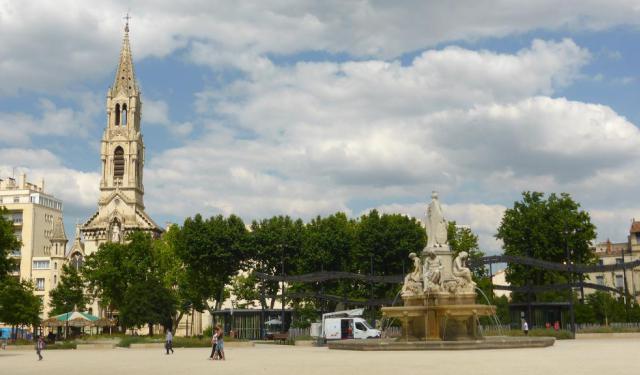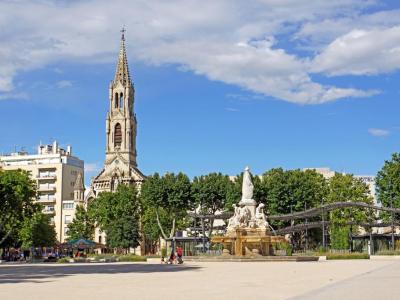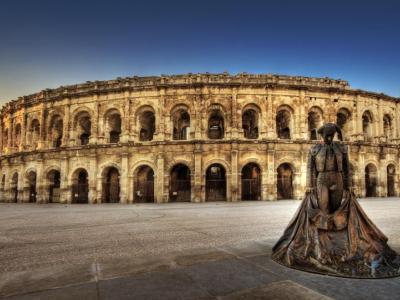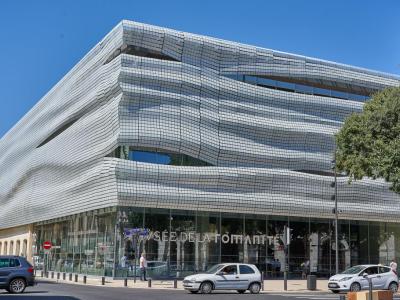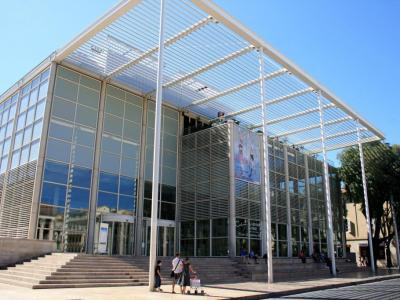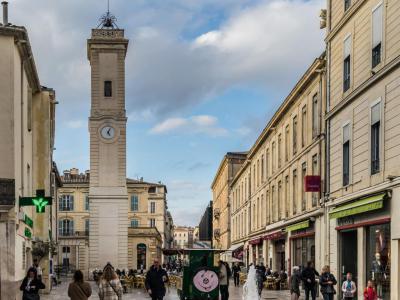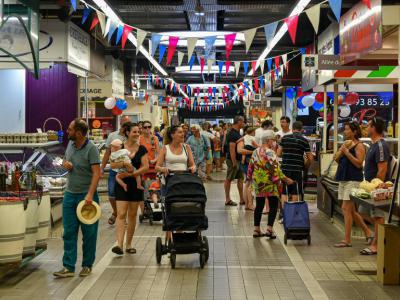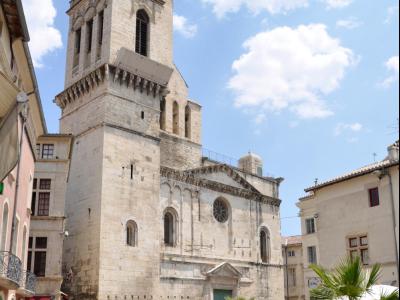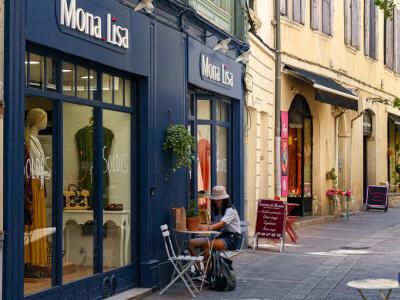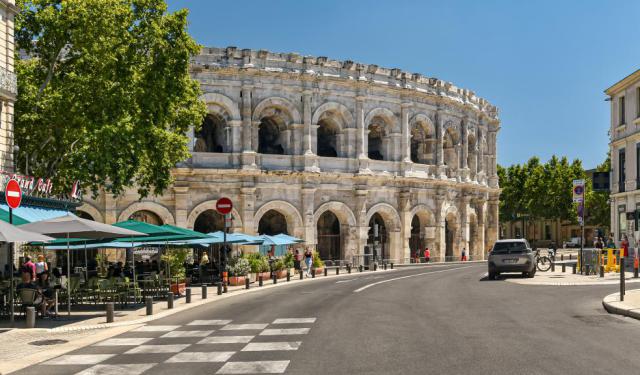Nimes Introduction Walking Tour (Self Guided), Nimes
Dubbed the most Roman city outside Italy, Nimes, a small city in Southern France, is steeped in history that harks back to the days of the mighty Roman Empire.
The name itself holds clues to the city's origin, reflecting Celtic roots and connection with the local god, Nemausus, associated with a healing spring.
The hill of Mount Cavalier, once an oppidum, served as the birthplace of the city. Nimes truly flourished during Roman times becoming a Roman colony, Colonia Nemausus, before 28 BC, where veterans of Julius Caesar's legions were granted land. Eventually, this regional capital had a population of 50,000–60,000. Several monuments from that era are still in place and have earned Nimes its nickname, the "French Rome".
The so-called Square House (Maison Carrée), a true architectural marvel from the late 1st century BC, stands as one of the best-preserved Roman temples globally. But what truly captivates visitors is the Arena of Nimes (Arenes de Nîmes), an ancient Roman amphitheater whose impressive capacity to hold thousands of spectators makes it easy to imagine the grandeur of events that once took place within its walls.
For a deeper dive into Nimes' Roman history, the local Museum of Romanity is a treasure trove of artifacts and exhibits that shed light on the city's glorious past.
Over the centuries, Nimes faced the challenges of history, including Visigoth rule in 472 and later, the Umayyad conquest in 725. The city witnessed turmoil and transformation but retained its Roman heritage.
Carolingian rule brought relative stability, and Nimes enjoyed prosperity during the 17th century, marked by population growth, urban expansion, and cultural renaissance. In more recent times, the city endured the trials of World War II, with American bombings in 1944 damaging and destroying several historical sites.
One of the prominent landmarks in Nimes is the Charles-de-Gaulle Esplanade, a vast open space that offers a perfect starting point for exploring the city.
To experience the heart of Nimes, a visit to Nimes Market Halls (Les Halles de Nîmes) is a must. These halls offer an array of fresh produce, local delicacies, and artisanal goods. It's a sensory delight and a chance to immerse yourself in the city's culinary culture.
Still, to discover all that this dreamy southern town has to offer, you should wind yourself around its picturesque streets. Nimes seamlessly blends its ancient heritage with modernity, offering a captivating mix of history, culture, and art. So, pack your bags, set out on an adventure, and immerse yourself in its timeless allure!
The name itself holds clues to the city's origin, reflecting Celtic roots and connection with the local god, Nemausus, associated with a healing spring.
The hill of Mount Cavalier, once an oppidum, served as the birthplace of the city. Nimes truly flourished during Roman times becoming a Roman colony, Colonia Nemausus, before 28 BC, where veterans of Julius Caesar's legions were granted land. Eventually, this regional capital had a population of 50,000–60,000. Several monuments from that era are still in place and have earned Nimes its nickname, the "French Rome".
The so-called Square House (Maison Carrée), a true architectural marvel from the late 1st century BC, stands as one of the best-preserved Roman temples globally. But what truly captivates visitors is the Arena of Nimes (Arenes de Nîmes), an ancient Roman amphitheater whose impressive capacity to hold thousands of spectators makes it easy to imagine the grandeur of events that once took place within its walls.
For a deeper dive into Nimes' Roman history, the local Museum of Romanity is a treasure trove of artifacts and exhibits that shed light on the city's glorious past.
Over the centuries, Nimes faced the challenges of history, including Visigoth rule in 472 and later, the Umayyad conquest in 725. The city witnessed turmoil and transformation but retained its Roman heritage.
Carolingian rule brought relative stability, and Nimes enjoyed prosperity during the 17th century, marked by population growth, urban expansion, and cultural renaissance. In more recent times, the city endured the trials of World War II, with American bombings in 1944 damaging and destroying several historical sites.
One of the prominent landmarks in Nimes is the Charles-de-Gaulle Esplanade, a vast open space that offers a perfect starting point for exploring the city.
To experience the heart of Nimes, a visit to Nimes Market Halls (Les Halles de Nîmes) is a must. These halls offer an array of fresh produce, local delicacies, and artisanal goods. It's a sensory delight and a chance to immerse yourself in the city's culinary culture.
Still, to discover all that this dreamy southern town has to offer, you should wind yourself around its picturesque streets. Nimes seamlessly blends its ancient heritage with modernity, offering a captivating mix of history, culture, and art. So, pack your bags, set out on an adventure, and immerse yourself in its timeless allure!
How it works: Download the app "GPSmyCity: Walks in 1K+ Cities" from Apple App Store or Google Play Store to your mobile phone or tablet. The app turns your mobile device into a personal tour guide and its built-in GPS navigation functions guide you from one tour stop to next. The app works offline, so no data plan is needed when traveling abroad.
Nimes Introduction Walking Tour Map
Guide Name: Nimes Introduction Walking Tour
Guide Location: France » Nimes (See other walking tours in Nimes)
Guide Type: Self-guided Walking Tour (Sightseeing)
# of Attractions: 9
Tour Duration: 1 Hour(s)
Travel Distance: 1.8 Km or 1.1 Miles
Author: DanaOffice
Sight(s) Featured in This Guide:
Guide Location: France » Nimes (See other walking tours in Nimes)
Guide Type: Self-guided Walking Tour (Sightseeing)
# of Attractions: 9
Tour Duration: 1 Hour(s)
Travel Distance: 1.8 Km or 1.1 Miles
Author: DanaOffice
Sight(s) Featured in This Guide:
- Esplanade Charles-de-Gaulle (Charles de Gaulle Esplanade)
- Arenes de Nimes (Arena of Nîmes)
- Musee de la Romanite (Museum of Roman Civilization)
- Carre d'Art (Museum of Modern Art)
- Maison Carree (Square House)
- Place de l'Horloge (Clock Square)
- Les Halles de Nimes (Nimes Market Halls)
- Nimes Cathedral
- Rue de l'Aspic (Aspic Street)
1) Esplanade Charles-de-Gaulle (Charles de Gaulle Esplanade)
The Charles-de-Gaulle Esplanade is a grand city square situated just across from the iconic Roman Arena. This expansive square pays tribute to the French soldier, resistance fighter, statesman, and writer Charles de Gaulle (1890-1970), who played a significant role in French history. The creation of this esplanade can be traced back to the first half of the 16th century when the consul Jacques d'Albenas initiated the construction of a platform designed for artillery exercises. Moreover, the square to the south of the crown gate also served as a site for the official reception of notable figures visiting the city.
While certain developments took place during the 17th century, it was only in the 19th century that the esplanade transformed into a genuine place for leisurely strolls. In 1841, the Nîmes municipal council embarked on a project to enhance Avenue Feuchères and the esplanade, which included upgrading the area into the present-day Boulevard de la Libération. This renovation introduced new semi-circular pathways, adorned with clusters of trees, flowers, and balustrades. The development of the esplanade culminated in 1851 with the unveiling of a monumental fountain, a masterpiece by the sculptor James Pradier.
This contemporary esplanade prominently features the Pradier fountain as its central element. The fountain's allegorical depiction represents the city of Nîmes, surrounded by four major rivers in the Nîmes region. Surrounding the pool, there's a spacious triangular stabilized area. To the south, the square offers benches, lawns, Mediterranean flora and trees, as well as bamboo-covered pergolas. Several kiosks, including a branch of the tourist office, enhance the overall experience. Additionally, a 1.40-meter-wide canal commences its course and leads to Avenue Feuchères, ultimately arriving in front of the train station, lined with plane trees.
Several prominent buildings border the esplanade, including the Nîmes Arena to the west, the courthouse to the north, and the churches of Sainte-Perpétue and Sainte-Félicité to the east. This grand square, with its rich history and contemporary beauty, provides a wonderful place for both locals and visitors to enjoy the heart of Nimes and its remarkable surroundings.
While certain developments took place during the 17th century, it was only in the 19th century that the esplanade transformed into a genuine place for leisurely strolls. In 1841, the Nîmes municipal council embarked on a project to enhance Avenue Feuchères and the esplanade, which included upgrading the area into the present-day Boulevard de la Libération. This renovation introduced new semi-circular pathways, adorned with clusters of trees, flowers, and balustrades. The development of the esplanade culminated in 1851 with the unveiling of a monumental fountain, a masterpiece by the sculptor James Pradier.
This contemporary esplanade prominently features the Pradier fountain as its central element. The fountain's allegorical depiction represents the city of Nîmes, surrounded by four major rivers in the Nîmes region. Surrounding the pool, there's a spacious triangular stabilized area. To the south, the square offers benches, lawns, Mediterranean flora and trees, as well as bamboo-covered pergolas. Several kiosks, including a branch of the tourist office, enhance the overall experience. Additionally, a 1.40-meter-wide canal commences its course and leads to Avenue Feuchères, ultimately arriving in front of the train station, lined with plane trees.
Several prominent buildings border the esplanade, including the Nîmes Arena to the west, the courthouse to the north, and the churches of Sainte-Perpétue and Sainte-Félicité to the east. This grand square, with its rich history and contemporary beauty, provides a wonderful place for both locals and visitors to enjoy the heart of Nimes and its remarkable surroundings.
2) Arenes de Nimes (Arena of Nîmes) (must see)
The Arena of Nîmes is a magnificent Roman amphitheatre. Erected around 100 CE, shortly after the renowned Colosseum of Rome, this arena stands as one of the world's most exceptionally preserved Roman amphitheatres. With its remarkable dimensions, the Arena of Nîmes measures 133 meters (436 feet) in length and 101 meters (331 feet) in width, featuring an arena that spans 68 by 38 meters (223 by 125 feet). Its grand outer facade soars to a height of 21 meters (69 feet) and boasts two storeys adorned with 60 arcades. Among the 400 Roman amphitheatres known to exist, it ranks among the 20 largest.
In ancient times, this grand structure had the capacity to accommodate a crowd of 24,000 spectators, who were accommodated across 34 tiers of terraces divided into four self-contained zones or maeniana. The arena served a dual purpose, functioning as a venue for public events and theatrical performances while also hosting gladiator battles that captivated the masses.
Presently, the Arena of Nîmes continues to play a central role in the city's cultural life. It hosts two annual bullfights as part of the Feria de Nîmes, attracting enthusiasts and spectators alike. Additionally, the arena serves as a captivating backdrop for various public events, including reenactments of antiquity such as "The Great Roman Games" and concerts. At its entrance, the statue of Christian Montcouquiol, known as Nimeño II, stands proudly, earning it the name "Hero."
Notably, in 1853, an unfortunate incident occurred at the arena when balloonist M. Louis Deschamps tragically lost his life during his 120th flight. Despite adverse weather conditions that had prompted the mayor to cancel a planned parachute performance, the balloon took off as scheduled and encountered the inclement weather. Deschamps was ejected from the basket, and the balloon came down approximately half a mile away from the arena. This incident remains a somber part of the arena's history.
In ancient times, this grand structure had the capacity to accommodate a crowd of 24,000 spectators, who were accommodated across 34 tiers of terraces divided into four self-contained zones or maeniana. The arena served a dual purpose, functioning as a venue for public events and theatrical performances while also hosting gladiator battles that captivated the masses.
Presently, the Arena of Nîmes continues to play a central role in the city's cultural life. It hosts two annual bullfights as part of the Feria de Nîmes, attracting enthusiasts and spectators alike. Additionally, the arena serves as a captivating backdrop for various public events, including reenactments of antiquity such as "The Great Roman Games" and concerts. At its entrance, the statue of Christian Montcouquiol, known as Nimeño II, stands proudly, earning it the name "Hero."
Notably, in 1853, an unfortunate incident occurred at the arena when balloonist M. Louis Deschamps tragically lost his life during his 120th flight. Despite adverse weather conditions that had prompted the mayor to cancel a planned parachute performance, the balloon took off as scheduled and encountered the inclement weather. Deschamps was ejected from the basket, and the balloon came down approximately half a mile away from the arena. This incident remains a somber part of the arena's history.
3) Musee de la Romanite (Museum of Roman Civilization) (must see)
Opened in 2018 the Museum of Romanity breathes new life into the former Museum of Archaeology, previously situated at the historic Jesuits' College on the Boulevard Amiral-Courbet.
The museum's inception was driven by a series of remarkable archaeological discoveries made between 2006 and 2007 at the Allées Jaurès in Nîmes. These discoveries included a domus, or Roman house, and two extraordinary mosaics featuring scenes of Achilles and Pentheus. Notably, experts in the field of archaeology have drawn parallels between these findings and those uncovered in the renowned ancient city of Pompeii.
The Museum of Romanity seamlessly melds the original archaeology collection with these more recent and exceptional archaeological revelations. Housed within an ultra-modern building, which intriguingly resembles a "folded glass toga," the museum is strategically situated along the historic site of the old Roman ramparts, directly facing the iconic 2,000-year-old Arènes de Nîmes.
The exhibits span a wide temporal spectrum, encompassing items from the prehistoric Iron Age to Gallo-Roman relics such as ceramics, bronze tableware, lamps, toiletry articles, and clothing accessories.
Among the museum's standout attractions are its impressive Roman coin collection and meticulously detailed mosaics that vividly transport visitors back in time, offering glimpses into the everyday life of this bygone era.
Stepping outside, the museum's archaeological garden invites exploration, offering insights into the city's multifaceted ancient heritage. Landscaped with lush Mediterranean flora, this garden features three distinct levels, each representing a different historical period: pre-Roman, classical Roman, and post-Roman eras.
Designed with tourists in mind, the museum boasts a rooftop terrace that offers breathtaking panoramic views of the city. Additionally, visitors can explore a well-stocked bookstore and gift shop. For dining options, the Musée de la Romanité caters to various tastes. The Café du Musée, a casual eatery with entrance at 16 Boulevard des Arènes, serves breakfast, lunch, snacks, and evening meals daily, with sunny patio seating.
The museum's inception was driven by a series of remarkable archaeological discoveries made between 2006 and 2007 at the Allées Jaurès in Nîmes. These discoveries included a domus, or Roman house, and two extraordinary mosaics featuring scenes of Achilles and Pentheus. Notably, experts in the field of archaeology have drawn parallels between these findings and those uncovered in the renowned ancient city of Pompeii.
The Museum of Romanity seamlessly melds the original archaeology collection with these more recent and exceptional archaeological revelations. Housed within an ultra-modern building, which intriguingly resembles a "folded glass toga," the museum is strategically situated along the historic site of the old Roman ramparts, directly facing the iconic 2,000-year-old Arènes de Nîmes.
The exhibits span a wide temporal spectrum, encompassing items from the prehistoric Iron Age to Gallo-Roman relics such as ceramics, bronze tableware, lamps, toiletry articles, and clothing accessories.
Among the museum's standout attractions are its impressive Roman coin collection and meticulously detailed mosaics that vividly transport visitors back in time, offering glimpses into the everyday life of this bygone era.
Stepping outside, the museum's archaeological garden invites exploration, offering insights into the city's multifaceted ancient heritage. Landscaped with lush Mediterranean flora, this garden features three distinct levels, each representing a different historical period: pre-Roman, classical Roman, and post-Roman eras.
Designed with tourists in mind, the museum boasts a rooftop terrace that offers breathtaking panoramic views of the city. Additionally, visitors can explore a well-stocked bookstore and gift shop. For dining options, the Musée de la Romanité caters to various tastes. The Café du Musée, a casual eatery with entrance at 16 Boulevard des Arènes, serves breakfast, lunch, snacks, and evening meals daily, with sunny patio seating.
4) Carre d'Art (Museum of Modern Art)
In the heart of Nîmes, where ancient architecture dominates the landscape, the Museum of Modern Art stands as a strikingly modern structure designed by renowned architect Norman Foster. This museum of modern art provides a refreshing contrast to the city's historical surroundings.
The Museum of Modern Art boasts a remarkable permanent collection that encompasses approximately 600 contemporary art pieces, spanning from the 1960s to the present day. The collection is thoughtfully organized around various themes, including sections dedicated to French art and Mediterranean art. These thematic divisions allow visitors to explore and appreciate the diverse artistic expressions of contemporary creators.
This cultural institution is more than just a museum; it's a prestigious hub of artistic and intellectual exchange. The Carré d'Art-Museum of Modern Art enjoys a special partnership with the world-renowned Centre Pompidou, a leading museum in Paris. Much like its Parisian counterpart, the Carré d'Art fulfills a dual role, serving as both a museum and a dynamic cultural center.
Throughout the year, the museum hosts a rotating array of temporary exhibitions featuring various forms of contemporary art, including photography. Additionally, the Carré d'Art offers engaging art workshops that allow visitors to actively participate in the creative process. For those looking to delve deeper into contemporary art, a well-stocked bookshop and a multimedia library are available, offering resources and literature related to this ever-evolving artistic field.
The Museum of Modern Art boasts a remarkable permanent collection that encompasses approximately 600 contemporary art pieces, spanning from the 1960s to the present day. The collection is thoughtfully organized around various themes, including sections dedicated to French art and Mediterranean art. These thematic divisions allow visitors to explore and appreciate the diverse artistic expressions of contemporary creators.
This cultural institution is more than just a museum; it's a prestigious hub of artistic and intellectual exchange. The Carré d'Art-Museum of Modern Art enjoys a special partnership with the world-renowned Centre Pompidou, a leading museum in Paris. Much like its Parisian counterpart, the Carré d'Art fulfills a dual role, serving as both a museum and a dynamic cultural center.
Throughout the year, the museum hosts a rotating array of temporary exhibitions featuring various forms of contemporary art, including photography. Additionally, the Carré d'Art offers engaging art workshops that allow visitors to actively participate in the creative process. For those looking to delve deeper into contemporary art, a well-stocked bookshop and a multimedia library are available, offering resources and literature related to this ever-evolving artistic field.
5) Maison Carree (Square House) (must see)
The Square House stands as a remarkable testament to Roman architecture and religious devotion in the charming city of Nîmes. This ancient Roman temple is celebrated as one of the best-preserved examples of Roman temples within the former Roman Empire's territory. It served as a mid-sized Augustan provincial temple dedicated to the Imperial cult, specifically as a caesareum.
The Maison Carrée has had a profound influence on architecture throughout history. It inspired the design of neoclassical structures such as the Église de la Madeleine in Paris, the St. Marcellinus Church in Rogalin, Poland, and, notably, the Virginia State Capitol in the United States. The Virginia State Capitol's design was the work of Thomas Jefferson, who, during his time as the Minister to France in 1785, had a stucco model of the Maison Carrée created. This temple's enduring impact extends across continents and centuries.
In recognition of its cultural significance and architectural splendor, the Maison Carrée was inscribed on the UNESCO World Heritage List in September 2023. Its historical origins date back to around 4–7 AD, when the temple was dedicated or rededicated to Gaius and Lucius Caesar, the grandsons and adopted heirs of Augustus, both of whom met untimely demises. Over the centuries, the original dedication inscription to Gaius and Lucius was lost, but in 1758, a local scholar, Jean-François Séguier, meticulously reconstructed the inscription based on the arrangement and number of holes on the front frieze and architrave, which had once held bronze letters.
The Maison Carrée embodies elements of a Tuscan-style Roman temple as described by Vitruvius, a Roman writer on architecture from the same era, albeit with the use of the Corinthian order. Elevated on a substantial podium, standing 2.85 meters high, the temple exhibits dimensions of 26.42 meters in length and 13.54 meters in width, creating a rectangular structure that is nearly twice as long as it is wide. Its imposing façade features a deep portico or pronaos that extends almost one-third of the building's total length, lavishly adorned with ornate columns and capitals. The presence of this extensive porch distinctly highlights the temple's frontal aspect, setting it apart from the designs of ancient Greek temples.
Upon entering through a grand door measuring 6.87 meters in height and 3.27 meters in width, visitors encounter the small, windowless interior, which originally housed the temple's shrine. Today, this space is used to host a film presentation that offers insights into Nîmes' rich Roman history. Although no ancient decorations remain within the cella, the Maison Carrée's architectural and historical significance continues to captivate visitors from around the world.
The Maison Carrée has had a profound influence on architecture throughout history. It inspired the design of neoclassical structures such as the Église de la Madeleine in Paris, the St. Marcellinus Church in Rogalin, Poland, and, notably, the Virginia State Capitol in the United States. The Virginia State Capitol's design was the work of Thomas Jefferson, who, during his time as the Minister to France in 1785, had a stucco model of the Maison Carrée created. This temple's enduring impact extends across continents and centuries.
In recognition of its cultural significance and architectural splendor, the Maison Carrée was inscribed on the UNESCO World Heritage List in September 2023. Its historical origins date back to around 4–7 AD, when the temple was dedicated or rededicated to Gaius and Lucius Caesar, the grandsons and adopted heirs of Augustus, both of whom met untimely demises. Over the centuries, the original dedication inscription to Gaius and Lucius was lost, but in 1758, a local scholar, Jean-François Séguier, meticulously reconstructed the inscription based on the arrangement and number of holes on the front frieze and architrave, which had once held bronze letters.
The Maison Carrée embodies elements of a Tuscan-style Roman temple as described by Vitruvius, a Roman writer on architecture from the same era, albeit with the use of the Corinthian order. Elevated on a substantial podium, standing 2.85 meters high, the temple exhibits dimensions of 26.42 meters in length and 13.54 meters in width, creating a rectangular structure that is nearly twice as long as it is wide. Its imposing façade features a deep portico or pronaos that extends almost one-third of the building's total length, lavishly adorned with ornate columns and capitals. The presence of this extensive porch distinctly highlights the temple's frontal aspect, setting it apart from the designs of ancient Greek temples.
Upon entering through a grand door measuring 6.87 meters in height and 3.27 meters in width, visitors encounter the small, windowless interior, which originally housed the temple's shrine. Today, this space is used to host a film presentation that offers insights into Nîmes' rich Roman history. Although no ancient decorations remain within the cella, the Maison Carrée's architectural and historical significance continues to captivate visitors from around the world.
6) Place de l'Horloge (Clock Square)
The Clock Square is a charming and historically significant square named after the prominent clock tower that graces its surroundings. This elegant campanile stands at a height of 31 meters and is crowned with a wrought iron bell, creating a distinctive landmark that has made Clock Square a popular meeting place for both locals and visitors.
The history of this monument is closely intertwined with Nîmes itself. In 1410, the city's residents sought and obtained permission from the King to erect a clock tower with a public-use bell. Prior to this, the citizens relied on the bell of the Cathedral for timekeeping and as a warning signal during times of conflict or war. This shared use of the steeple led to disputes, including the canons' refusal to allow a sentinel on the church's belfry. The conflicts persisted until an agreement was reached to transfer the bell to the city. The decision was facilitated by a trade-off: the city agreed to ban foreign wines from entering Nîmes, while the canons provided the bell. In return for their cooperation, wines produced in the canons' vineyards outside the Nîmes region were granted entry into the city.
The original clock tower faced the threat of ruin over the years. However, in 1752, it was reconstructed and adorned with an octagon-shaped wrought iron bell tower. This elegant structure not only tells the time but also serves as a symbol of Nîmes' rich history and culture.
Today, Clock Square is not only a historical landmark but also a vibrant hub, with a blend of shops and café terraces that make it a delightful destination for both locals and tourists. Here, amid the picturesque setting and the melodious chimes of the bell tower, visitors can enjoy the city's gastronomic specialty, Nîmes brandade, while soaking in the ambiance of this iconic square.
The history of this monument is closely intertwined with Nîmes itself. In 1410, the city's residents sought and obtained permission from the King to erect a clock tower with a public-use bell. Prior to this, the citizens relied on the bell of the Cathedral for timekeeping and as a warning signal during times of conflict or war. This shared use of the steeple led to disputes, including the canons' refusal to allow a sentinel on the church's belfry. The conflicts persisted until an agreement was reached to transfer the bell to the city. The decision was facilitated by a trade-off: the city agreed to ban foreign wines from entering Nîmes, while the canons provided the bell. In return for their cooperation, wines produced in the canons' vineyards outside the Nîmes region were granted entry into the city.
The original clock tower faced the threat of ruin over the years. However, in 1752, it was reconstructed and adorned with an octagon-shaped wrought iron bell tower. This elegant structure not only tells the time but also serves as a symbol of Nîmes' rich history and culture.
Today, Clock Square is not only a historical landmark but also a vibrant hub, with a blend of shops and café terraces that make it a delightful destination for both locals and tourists. Here, amid the picturesque setting and the melodious chimes of the bell tower, visitors can enjoy the city's gastronomic specialty, Nîmes brandade, while soaking in the ambiance of this iconic square.
7) Les Halles de Nimes (Nimes Market Halls)
Located in the heart of Nîmes, Les Halles is a vibrant covered market that offers a sensory feast for both your eyes and taste buds. This culinary haven brings together a diverse community of around a hundred artisans and traders who share a common passion for flavor.
Les Halles isn't merely a place to purchase exquisite products like picholine olives, freshly caught sea bream, or creamy Pélardons; it's a space to savor the joys of human connection and indulge in engaging conversations that naturally unfold.
A visit to Les Halles in Nimes isn't just a shopping expedition; it's an immersive experience. It's a place where locals and visitors alike come to meander through the market's enchanting stalls, sample the vast array of offerings, and partake in the art of conversation. The market hall hosts a diverse collection of vendors, each offering their unique treasures, from an abundance of fresh fruits and vegetables to artisanal bread, a rich selection of cheeses, and a delightful array of meat and fish.
Whether you're in search of the freshest ingredients for your next culinary masterpiece or simply wish to explore, Les Halles provides an opportunity to delight in the culinary wonders of Nîmes while connecting with the community and savoring the conviviality of this bustling marketplace.
Les Halles isn't merely a place to purchase exquisite products like picholine olives, freshly caught sea bream, or creamy Pélardons; it's a space to savor the joys of human connection and indulge in engaging conversations that naturally unfold.
A visit to Les Halles in Nimes isn't just a shopping expedition; it's an immersive experience. It's a place where locals and visitors alike come to meander through the market's enchanting stalls, sample the vast array of offerings, and partake in the art of conversation. The market hall hosts a diverse collection of vendors, each offering their unique treasures, from an abundance of fresh fruits and vegetables to artisanal bread, a rich selection of cheeses, and a delightful array of meat and fish.
Whether you're in search of the freshest ingredients for your next culinary masterpiece or simply wish to explore, Les Halles provides an opportunity to delight in the culinary wonders of Nîmes while connecting with the community and savoring the conviviality of this bustling marketplace.
8) Nimes Cathedral
Nîmes Cathedral is a significant Roman Catholic church dedicated to the Blessed Virgin Mary and Saint Castor of Apt, a local patron saint.
Throughout its history, Nîmes Cathedral has served as the seat of the Bishops of Nîmes until 1877 when the diocese underwent a name change. Despite this transformation, the cathedral still remains the ecclesiastical seat for their successors, the Bishops of Nîmes, Uzès, and Alès.
The cathedral is believed to occupy the site where the former temple of Augustus once stood. Its architecture is a blend of Romanesque and Gothic styles, showcasing the diverse historical influences that have shaped Nîmes over the centuries.
Upon approaching the cathedral, you'll immediately notice the western facade, which bears the scars of its tumultuous past. This exterior reflects the challenges the cathedral has faced throughout its existence.
The origins of a religious structure on this site can be traced back to the Roman temple of Augustus. Several elements of the cathedral's architecture, including the northwest tower and certain arches on the facade, were built in the 1100s. These elements endured the ravages of the French Wars of Religion in the 16th and 17th centuries.
As a result of the damage sustained, much of the cathedral underwent a significant reconstruction in the 19th century, adopting a neo-Gothic design. The interior also received a neo-Byzantine makeover, demonstrating the evolution of architectural styles and artistic influences over the years.
Inside the cathedral, visitors can admire the organ, which dates back to 1643 and features an intricately carved buffet. This historical instrument is protected as a French national monument, adding to the cultural and historical significance of Nîmes Cathedral.
Throughout its history, Nîmes Cathedral has served as the seat of the Bishops of Nîmes until 1877 when the diocese underwent a name change. Despite this transformation, the cathedral still remains the ecclesiastical seat for their successors, the Bishops of Nîmes, Uzès, and Alès.
The cathedral is believed to occupy the site where the former temple of Augustus once stood. Its architecture is a blend of Romanesque and Gothic styles, showcasing the diverse historical influences that have shaped Nîmes over the centuries.
Upon approaching the cathedral, you'll immediately notice the western facade, which bears the scars of its tumultuous past. This exterior reflects the challenges the cathedral has faced throughout its existence.
The origins of a religious structure on this site can be traced back to the Roman temple of Augustus. Several elements of the cathedral's architecture, including the northwest tower and certain arches on the facade, were built in the 1100s. These elements endured the ravages of the French Wars of Religion in the 16th and 17th centuries.
As a result of the damage sustained, much of the cathedral underwent a significant reconstruction in the 19th century, adopting a neo-Gothic design. The interior also received a neo-Byzantine makeover, demonstrating the evolution of architectural styles and artistic influences over the years.
Inside the cathedral, visitors can admire the organ, which dates back to 1643 and features an intricately carved buffet. This historical instrument is protected as a French national monument, adding to the cultural and historical significance of Nîmes Cathedral.
9) Rue de l'Aspic (Aspic Street)
Nimes boasts a plethora of charming specialized stores and souvenir shops that never fail to catch the eye of tourists. The majority of these sought-after shops can be found in the heart of the city, with the most enticing shopping destinations being Aspic Street, Général-Perrier Street and Madeleine Street. These shops may be on the pricier side, but they offer the finest in fashionable attire, exclusive souvenirs, and captivating works of art.
The Aspic Street is a charming destination for those seeking a delightful shopping experience. This street is a vibrant mix of high-street stores and unique, quirky boutiques, making it an excellent choice for shoppers with a diverse range of preferences. Whether you're in search of stylish clothing, accessories, distinctive gifts, or exquisite jewelry, Rue de l'Aspic has it all.
The street's historical roots add to its allure, with a fascinating transformation in nomenclature over the years. Originally known as rue des Epis, it was home to the residence of Jean Nicot in 1480, a notary who was the father of the renowned Jean Nicot, famed for bringing tobacco to France in the 16th century, ultimately serving as the French ambassador to Portugal.
Over time, the street's name evolved into rue de l'Espic, as evidenced by engravings on the Arnaud house at the corner of rue de Bernis. The current name, rue de l'Aspic, emerged through linguistic transformations and remains a must-visit location for shoppers and history enthusiasts alike.
The Aspic Street is a charming destination for those seeking a delightful shopping experience. This street is a vibrant mix of high-street stores and unique, quirky boutiques, making it an excellent choice for shoppers with a diverse range of preferences. Whether you're in search of stylish clothing, accessories, distinctive gifts, or exquisite jewelry, Rue de l'Aspic has it all.
The street's historical roots add to its allure, with a fascinating transformation in nomenclature over the years. Originally known as rue des Epis, it was home to the residence of Jean Nicot in 1480, a notary who was the father of the renowned Jean Nicot, famed for bringing tobacco to France in the 16th century, ultimately serving as the French ambassador to Portugal.
Over time, the street's name evolved into rue de l'Espic, as evidenced by engravings on the Arnaud house at the corner of rue de Bernis. The current name, rue de l'Aspic, emerged through linguistic transformations and remains a must-visit location for shoppers and history enthusiasts alike.
Walking Tours in Nimes, France
Create Your Own Walk in Nimes
Creating your own self-guided walk in Nimes is easy and fun. Choose the city attractions that you want to see and a walk route map will be created just for you. You can even set your hotel as the start point of the walk.
Ancient Roman Ruins in Nimes
Nicknamed “the French Rome,” the southern French town of Nimes is indeed the most Roman city outside of Italy. In large part, this is due to a wealth of architectural monuments that have remained here since the Roman era. Some ruined and some well-preserved, they offer a captivating glimpse into the ancient history stretching back to the early days of Roman expansion.
A true testament to... view more
Tour Duration: 2 Hour(s)
Travel Distance: 3.7 Km or 2.3 Miles
A true testament to... view more
Tour Duration: 2 Hour(s)
Travel Distance: 3.7 Km or 2.3 Miles
The Most Popular Cities
/ view all
